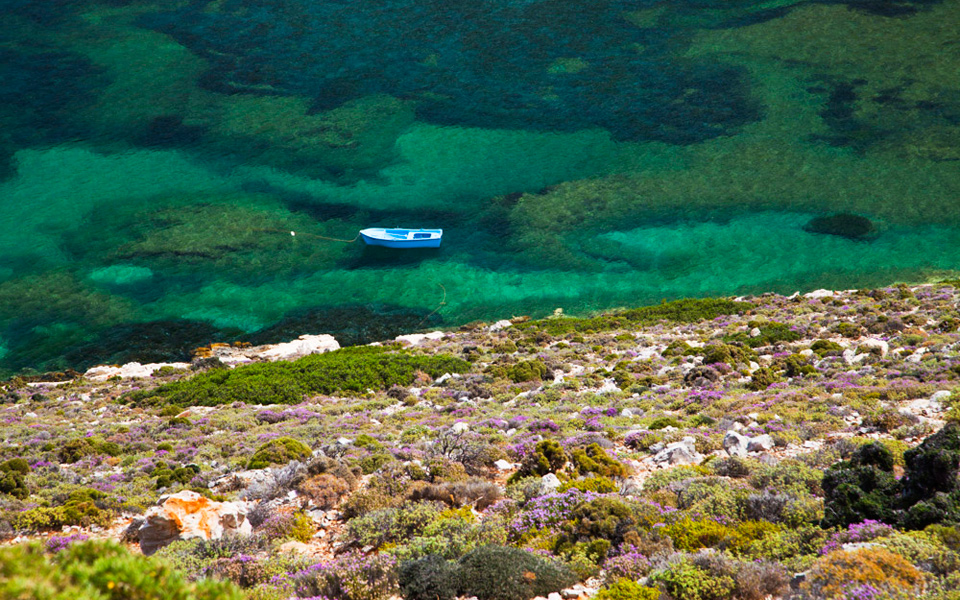Patmos: The Island We Love to Return to
Charming architecture, unique beaches, rich history,...

Climbing with a view to the islet of Telendos
© Shutterstock
What you see on Kalymnos is what you get. This Greek island, the fourth-largest of the Dodecanese chain in the southeast Aegean, steers clear of anything artificial and does not require any second readings. The locals are authentic and openhearted, a quality which has survived from the island’s humble sponge-diving past that taught the islanders to live the present to its fullest. Kalymnos is simple, lovely and quiet – except for September and October, the island’s busiest months, compared to other Greek islands. The very same rocks from which locals once plunged into the waters in search of sponges are nowadays being utilized by climbers. Kalymnos has developed into a major climbing attraction, while scuba diving, mountain hiking and spelunking (cave exploring and studying) are also popular.
Tens of thousands of people visit each year to climb the island’s rocks. The northwestern part of Kalymnos is filled with wall-like cliffs that are ideal for climbing. The rock climbing trend can be traced back to 1996 when a group of Italian visitors showed an appreciation for the island’s stone formations, climate and overall landscape. Rock climber Andrea di Bari forged the first routes. A Greek climber, Aris Theodoropoulos, added to the effort, in conjunction with the local municipality, to establish Kalymnos as a rock climbing Mecca. A total of around 70 routes and 300 suitable plains are scattered across the island. The majority of these, and most renowned, are located in the Masouri area. The island hosts an annual Rock Climbing Festival every October. The autumn season is regarded as the most appropriate season for rock climbing, which has helped generate an extended alternative-based tourism season for Kalymnos. The island’s shipwrecks, reefs teeming with life, and underwater caves are also an attraction for scuba divers.

Crystal clear waters around the island make it a great place for diving
© Olga Charami

Take in astounding panoramic views from the Panaghia Kyra-Psili monastery
© Olga Charami

Kalymnos is now equally as famous for rock climbing as it is for its sponges
© Olga Charami
Pothia, the island’s port-town and capital, sits in a large valley filled with multi-colored houses all the way to the sea. This town is charming and lively. Its Prefecture Hall, Town Hall and the Vouvalios Naval Academy buildings are key attractions. So, too, is the Sotiras Christos (Christ Saviour) church whose marble iconostasis (icon screen) was crafted by eminent Greek sculptor Yannoulis Chalepas. Situated further back are the Archaeological Museum and 15th-century Chrysoheria Castle, offering a splendid view.
In the past, locals turned to the sea for a living as a result of the island’s rocky terrain, establishing a sponge-diving, fishing and sailing tradition that shaped the social fabric of Kalymnos. A disease hit the eastern Mediterranean in the mid-80s, destroying a great number of sponges and damaging the sponge-fishing industry as a result. These days, approximately 100 locals are engaged in shell and sponge diving. A greater number focus on fishing. A total of 658 fishing boats, the Mediterranean’s biggest fishing fleet, are based on the island. “There are about 1,000 fishermen on Kalymnos and approximately 1,500 more are indirectly involved in fishing,” said Giorgos Katsotourhis, president of the local fishermen’s association. The figure includes women who prepare and package seafood delights sold under the Kalymnos Social Cooperative Company brand name. A few sponge workshops, where visitors may observe the entire processing procedure, operate in the fish market area.

The harbor of Pothia with its multicolored houses
© Olga Charami

The 10th century castle of Pothia
© Olga Charami

In the island’s east, a delightful route leads to Vathy and its remarkable fjord at the small Rina port
© Olga Charami
The road heading south from Pothia leads to Aghios Savvas church, the island’s major pilgrimage destination, and the “Kalymnian House”, where visitors can learn about local customs and the island’s sponge-harvesting past. The impressive Kefala Cave is located beyond Vlychadia, blessed with a lovely beach and charming small tavernas. Situated north of Pothia, the Chora, or Chorio, features interesting alleys, white-washed houses and a 10th century castle with unassuming churches, and stunning views.
In the island’s east, a delightful route leads to Vathy and its remarkable fjord at the small Rina port. From there, road signs lead to the charming Panaghia (Virgin Mary) Kyra-Psili monastery, reached after an additional 20-minute uphill hike. There is also a trail in the area, which leads to an Italian blockhouse or Pezonta beach, otherwise you can drive to Arginonta.
Emporeios, an ideal summer location, is located to the north. Alternatively, from Skalia, follow the road to Palioniso, through slopping landscapes, thyme,oregano and goats. The route offers spectacular views of the island of Leros and the rocky islet of Imia and the Turkish coast. The magical beach of Palionisos is always calm and tranquil, during winter or summer.
There is far more activity on the west coast where the island’s renowned rock climbing areas are located. The villages here have been developed to cater to rock climbing enthusiasts. The beaches are organized. Masouri is the top attraction among others, including Myrties, Panormos, Kantouni, Linaria and Platys Gialos. It is convenient to return to Pothia from here, via Argos and Damos, the location of Christos tis Ierousalim (Christ of Jerusalem), a unique monument in which fragments of the Temple of Apollo, the ancient city, Byzantine church mosaics and the restored Ypakoi Chapel all co-exist.
Otherwise, if you choose not to return to Pothia, the west coast offers a sensational view of nearby Telendos Island, dominated by an impressive steep rock. Watching the sun set here is a mesmerizing experience. For absolute silence and serenity, cross over to Telendos on one of the small boats running from Myrties.
Charming architecture, unique beaches, rich history,...
In Leonidio, Easter comes alive with...